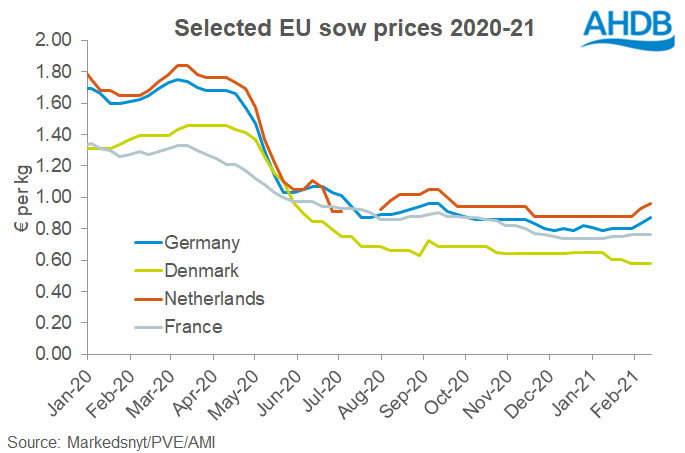A little uplift for the EU sow market
Tuesday, 23 February 2021
By Bethan Wilkins
Since the start of February, EU sow prices have moved up a little in a couple of key member states.
For the important German market, the average M1 sow price reached 87¢/kg in the middle of the month, the highest level since last October. Of course, this is still a very low price in historic terms.
The pound has strengthened against the euro recently. So, the sterling value of the German sow price has remained relatively stable since mid-December, at 67p/kg. This would be expected to inhibit any potential uplift in GB sow prices, which could follow on from German price growth.
Recently, the British sow market has been negatively affected by disruption to trade with Europe, due to regulatory changes now we have left the EU. This has been the dominant factor influencing sow prices here. There have also been coronavirus-related challenges. Lack of demand for British carcases from the continent significantly curtailed culling levels in January and reports indicate there is now a backlog of sows to cull. In the most recent weeks there does seem to be some movement on the sow market again. However, British prices remain at extremely low levels by historic standards.

The German price usually sets the tone for other member states, and indeed, we have also seen some uplift in the Dutch price in the past two weeks. However, the French price has remained stable so far. The Danish price also hasn’t seen any uplift, and in contrast to the other key states, recorded some decline earlier in 2021.
In Germany, sow slaughter levels have been relatively high so far this year, likely reflecting the difficult financial position of producers. The longer-term outlook is also more challenging, with changes to regulation making pig breeding less attractive. The latest census results from Germany show a declining breeding herd and a sharp fall has also been reported in the Netherlands. Higher sow slaughter levels may also be a limitation for sow prices, though the recent slight uplift might indicate some improvement in demand.
Of course, sow culling also suggests there is a possible tightening of finished pig supplies ahead. Eventually, this may enable better prices for both clean pigs and sows. Improvement in demand levels, associated with any lessening of coronavirus-related restrictions, could be another factor facilitating some price recovery in the future.
Sign up for regular updates
Subscribe to receive pork market news straight to your inbox. Simply complete our online form.
While AHDB seeks to ensure that the information contained on this webpage is accurate at the time of publication, no warranty is given in respect of the information and data provided. You are responsible for how you use the information. To the maximum extent permitted by law, AHDB accepts no liability for loss, damage or injury howsoever caused or suffered (including that caused by negligence) directly or indirectly in relation to the information or data provided in this publication.
All intellectual property rights in the information and data on this webpage belong to or are licensed by AHDB. You are authorised to use such information for your internal business purposes only and you must not provide this information to any other third parties, including further publication of the information, or for commercial gain in any way whatsoever without the prior written permission of AHDB for each third party disclosure, publication or commercial arrangement. For more information, please see our Terms of Use and Privacy Notice or contact the Director of Corporate Affairs at info@ahdb.org.uk © Agriculture and Horticulture Development Board. All rights reserved.

